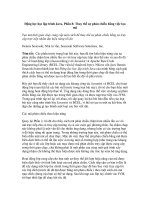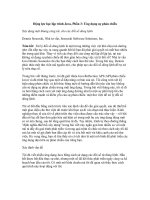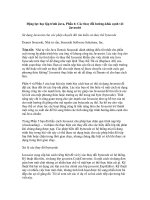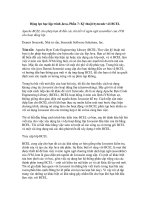Lập trình Java script tự học
Bạn đang xem bản rút gọn của tài liệu. Xem và tải ngay bản đầy đủ của tài liệu tại đây (842.29 KB, 125 trang )
JavaScript
1
Content
•
•
•
•
•
•
•
1. Introduction
2. Syntax
3. Variables and Operators
4. JavaScript Operators
5. Conditional statements
6. For loops
7. While loops
2
Content
•
•
•
•
•
•
•
8. Alert, Confirm and Prompt
9. Functions 1
10. Functions 2
11. Strings
12. Arrays
13. Associative Arrays
14. References
3
1. Introduction
• First developed by Netscape
• Ease traffic between server and client
• Ten fundamental aspects:
–
–
–
–
–
–
–
–
–
–
Can be included in HTML
Dependent on the environment
Interpreted language
Flexible language
Based on objects
Event driven
Is not Java
Many-functionally
Is evolving
Covers diverse context
4
2. Syntax
• Adding JavaScript in an HTML page
• Hiding code in old browsers
• Syntax conventions
5
2.1 Adding JavaScript in an HTML page
• Use “<script>” and “</script>”
• JavaScript code can be added:
– In HTML file
– In an external .js file
6
2.1 Adding JavaScript in an HTML page
Figure 1: JavaScript written within web page
7
2.1 Adding JavaScript in an HTML page
Figure 2: JavaScript written in an external file
8
2.2 Hiding code in old browsers
• Avoid the appearance of JS code on web page
• To hide code, use “<!-- and “-->”
• Example:
<script type="text/javascript">code block
--></script>
9
2.3 Syntax conventions
•
•
•
•
•
•
•
Case-sensitive
Semicolon (;)
Blank spaces
Quotes
Special Characters
Comments
The name of the variables and functions
10
2.3.1 Case-sensitive
• Makes distinction between large and small
letters
• Example:
– examples and Examples will be treated differently
11
2.3.2 Semicolon
• All line statements must end with a “;”
• Example:
– var1 = 3;
– var2 = 8;
12
2.3.3 Blank spaces
• JS ignores blank spaces in instructions
• Example:
var=1;
is the same as
var =
1;
13
2.3.4 Quotes
• Used to delimit strings
• Example:
– ‘I learn JavaScript’
– “I learn JavaScript”
14
2.3.5 Special Characters
•
•
•
•
\b
\r
\’
Example:
\f
\t
\”
\n
\\
To display text: “JavaScript” Course \
Use syntax:
document.write ("\" JavaScript \" Course \\")
15
2.3.6 Comments
• To specify role of variables, instructions
• To add comment on a single line, use: //
– Example: //Comment on a single line
• To add comments on multiple lines, use
– /* and */
– Example:
/* comment on ...
multiple lines
... */
16
2.3.7 The name of the variables and functions
• First character must be:
– A letter
– An underscore
– A $ sign
• First character can not be a number
• Name should not contain blank space
• Do not use reserved words
17
3. Variables and Operators
• Using variables
• Operators
18
3.1 Using variables
• Used to store data
• Variable Types:
– No fixed types of data
– Examples:
var x = "xyz";
x = 8;
• Life spam of a variable:
– Local
– Global
19
3.2 Operators
• Definition:
– Are symbols determining how data are modified
– Used to work with data, change variable’s value
• Operator kinds:
– Binary
– Unary
• Operator types:
Arithmetic Assigning
Comparison
Logical
Strings Operators
Conditional Functions Operators
Objects Operators
Logical
Typeof
20
4. JavaScript Operators
•
•
•
•
•
•
•
Arithmetic operators
Comparison operators
Strings operators
Functions operators
Objects operators
Conditional operators
Operators precedence
Assigning operators
Logical operators
Typeof operators
21
4.1 Arithmetic operators
• “=“:
– used to assign values
– Example: x = 8;
• “+“:
– used to add values
– Example: x = 7+8;
• “-“:
– subtraction
– Example: x = 7-8;
22
4.1 Arithmetic operators
• “*“:
– multiplication
– Example: x = 7*8;
• “/“:
– division
– Example: x = 7/8;
• “%“:
– modulo
– Example: x = 8%3;
23
4.1 Arithmetic operators
• “++“:
– increment
– Example: x++;
• “--“:
– decrement
– Example: x--;
24
4.2 Assigning operators
Table 1: Assigning operators
25









